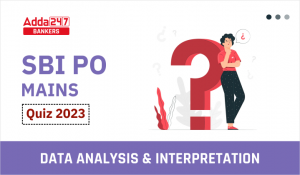Dear Aspirants,
Banking Awareness for SBI PO/Clerk Exam 2018
With the increased competition in the field of banking examinations, it has now become very important to cover up all the sections efficiently. One subject that can help you bagging graceful marks in the minimum time in these examinations is Banking Awareness. Banking Awareness Quiz not only helps you deal with the General Awareness Section of Banking Exams but also, the Personal Interview round of Banking Recruitment.
Q1. SBI Act was passed in Parliament in-
(a) 1935
(b) 1949
(c) 1955
(d) 1969
(e) 1980
S1. Ans.(c)
Sol. SBI Act was passed in Parliament in 1955.
Sol. SBI Act was passed in Parliament in 1955.
Q2. Generally, the minimum rate below which the banks do not lend is known as-?
(a) floor rate
(b) repo rate
(c) highest rate
(d) base rate
(e) All of the above
S2. Ans.(d)
Sol. Base rate is the minimum rate set by the Reserve Bank of India below which banks are not allowed to lend to its customers.
Sol. Base rate is the minimum rate set by the Reserve Bank of India below which banks are not allowed to lend to its customers.
Q3. Which of the following banks has acquired the ‘Centurion Bank of Punjab’?
(a) ICICI Bank
(b) IDBI Bank
(c) HDFC Bank
(d) AXIS Bank
(e) SBI
S3. Ans.(c)
Sol. HDFC Bank has acquired the ‘Centurion Bank of Punjab’.
Sol. HDFC Bank has acquired the ‘Centurion Bank of Punjab’.
Q4. What was the deposits criteria of 14 banks nationalized on 19th July 1969?
(a) Over Rs. 1000 crore
(b) Over Rs. 500 crore
(c) Over Rs. 100 crore
(d) Over Rs. 50 crore
(e) Over Rs. 200 crore
S4. Ans.(d)
Sol. 14 major Indian Scheduled Commercial Banks with deposits of over Rs 50 crores nationalized ‘ to serve better the needs of development of the economy in conformity with national policy objectives’.
Sol. 14 major Indian Scheduled Commercial Banks with deposits of over Rs 50 crores nationalized ‘ to serve better the needs of development of the economy in conformity with national policy objectives’.
Q5. Board for Financial Supervision (BFS) constituted in 1994 by RBI to undertake consolidated supervision of
(a) commercial banks
(b) financial institutions
(c) non-banking finance companies
(d) All of the above
(e) None of the given options is true
S5. Ans.(d)
Sol. The Reserve Bank of India performs this function under the guidance of the Board for Financial Supervision (BFS). The Board was constituted in November 1994 as a committee of the Central Board of Directors of the Reserve Bank of India. Primary objective of BFS is to undertake consolidated supervision of the financial sector comprising commercial banks, financial institutions and non-banking finance companies.
Sol. The Reserve Bank of India performs this function under the guidance of the Board for Financial Supervision (BFS). The Board was constituted in November 1994 as a committee of the Central Board of Directors of the Reserve Bank of India. Primary objective of BFS is to undertake consolidated supervision of the financial sector comprising commercial banks, financial institutions and non-banking finance companies.
Q6. Who is a very senior citizen under Income Tax Rules?
(a) A person who is 65 years and above
(b) A person who is 75 years and above
(c) A person who is 80 years and above
(d) A person who is 90 years and above
(e) A person who completed 100 years of age
S6. Ans.(c)
Sol. Any Indian resident citizen whose age is 80 years or above at any time during the respective year falls under the term very Senior Citizen under Income Tax Rules.
Sol. Any Indian resident citizen whose age is 80 years or above at any time during the respective year falls under the term very Senior Citizen under Income Tax Rules.
Q7. SEBI, a regulator of the securities market in India was established in the year 1988, but was empowered with statutory Powers in the form of Act in the year-
(a) 1990
(b) 1991
(c) 1992
(d) 1993
(e) 1998
S7. Ans.(c)
Sol. SEBI, a regulator of securities market in India was established in the year 1988, but was empowered with statutory Powers in the form of Act in 1992.
Sol. SEBI, a regulator of securities market in India was established in the year 1988, but was empowered with statutory Powers in the form of Act in 1992.
Q8. Name of premier institution that is taking care of the financial needs of importers and exporters of our country which was established in the year 1981.
(a) EXPO Bank
(b) Export-Import Bank (EXIM)
(c) Merchant Bank
(d) ECGC
(e) RBI
S8. Ans.(b)
Sol. Exim Bank’s Vision has evolved from a product-centric approach with Export Credits and Export Capability Creation, to a more customer-centric approach by offering a comprehensive range of products and services to empower businesses at all stages of a company’s business cycle. Today, we develop commercially viable relationships with a target set of externally oriented companies through a comprehensive range of products and services, aimed at enhancing their internationalisation efforts. Going ahead, we aspire to utilise our leadership and expertise in Export Finance to make a lasting difference to Indian companies with global aspirations. The Bank’s Mission is to facilitate globalisation of Indian Business.
Sol. Exim Bank’s Vision has evolved from a product-centric approach with Export Credits and Export Capability Creation, to a more customer-centric approach by offering a comprehensive range of products and services to empower businesses at all stages of a company’s business cycle. Today, we develop commercially viable relationships with a target set of externally oriented companies through a comprehensive range of products and services, aimed at enhancing their internationalisation efforts. Going ahead, we aspire to utilise our leadership and expertise in Export Finance to make a lasting difference to Indian companies with global aspirations. The Bank’s Mission is to facilitate globalisation of Indian Business.
Q9. SMERA is an SME Rating Agency in India meant for-
(a) rating on credit worthiness of MSME
(b) rating on quality management
(c) rating on the training system
(d) rating on technology usage in (the organization)
(e) None of the given options is true
S9. Ans.(a)
Sol. SMERA Ratings Ltd is a full-service credit rating agency exclusively set up for micro, small and medium enterprises in India and has grown to rate SME, mid & large corporate.
Sol. SMERA Ratings Ltd is a full-service credit rating agency exclusively set up for micro, small and medium enterprises in India and has grown to rate SME, mid & large corporate.
Q10. FIPB stands for-
(a) Foreign Investment Permanent Board
(b) Foreign Industrial Promotion Board
(c) Foreign Investment Promotion Board
(d) Financial Investment Promotion Board
(e) None of the given options is true
S10. Ans.(c)
Sol. The Foreign Investment Promotion Board (FIPB) was a national agency of Government of India, with the remit to consider and recommend foreign direct investment which does not come under the automatic route.
Sol. The Foreign Investment Promotion Board (FIPB) was a national agency of Government of India, with the remit to consider and recommend foreign direct investment which does not come under the automatic route.
Q11. CGTMSE stands for
(a) Central Government Fund Trust Medium and Small Enterprises
(b) Credit Guarantee Fund for Medium Enterprises
(c) Central Government Transfer Fund Multispecialty Micro Enterprises
(d) Credit Guarantee Fund Trust for Micro and Small Enterprises
(e) None of the given options is true
S11. Ans.(d)
Sol. Availability of bank loan without any collateral is a major requirement for boosting first Generation Entrepreneurship in India. The CGTMSE scheme or Credit Guarantee Fund Trust for Micro and Small Enterprises (CGTMSE) is operationalized by SIDBI and the Government of India.
Sol. Availability of bank loan without any collateral is a major requirement for boosting first Generation Entrepreneurship in India. The CGTMSE scheme or Credit Guarantee Fund Trust for Micro and Small Enterprises (CGTMSE) is operationalized by SIDBI and the Government of India.
Q12. A ‘Debit Card’ is issued by a bank to-
(a) all customers of a bank
(b) all customers having Savings bank account with a bank
(c) all customers having the loan account with a bank
(d) a bank customer who is income tax assesses
(e) all corporate Salary account holder
S12. Ans.(b)
Sol. A ‘Debit Card’ is issued by a bank to all customers having Savings bank account with a bank.
Sol. A ‘Debit Card’ is issued by a bank to all customers having Savings bank account with a bank.
Q13. A lot of Banks in India these days are offering M-Banking Facility to their customers. What is the full form of ‘M’ in “M-Banking’?
(a) Money
(b) Marginal
(c) Message
(d) Mutual Fund
(e) Mobile
S13. Ans.(e)
Sol. M-Banking stands for Mobile Banking.
Sol. M-Banking stands for Mobile Banking.
Q14. Which of the following is the limitation of the ATMs owing to which people are required to visit branches of the bank?
I. It does not accept deposits.
II. It has a limited cash disbursement capacity.
III. Lack of cash availability 24*7
Select the correct answer using the codes given below.
(a) Only I
(b) Only II
(c) Only III
(d) III, II and I
(e) None of the given options is true
S14. Ans.(d)
Sol. All III, II and I are true.
Q15. A Bank/Financial Organisation these days relies heavily on e-commerce for its transaction. As a part of system security, it has introduced the organization’s security awareness manual. This step of the organization can be classified under, which one of the following categories of measures for a business?
(a) Preventative
(b) Compliance
(c) Corrective
(d) Detective
(e) None of the given options is true
S15. Ans.(a)
Sol. Use preventative measures for business continuity. Risk management involves putting processes, methods and tools in place to deal with the outcomes of events you have identified as major threats for your business.






 Quantitative Aptitude Quiz For SBI PO Ma...
Quantitative Aptitude Quiz For SBI PO Ma...
 Inequalities Basic Reasoning Quiz for Al...
Inequalities Basic Reasoning Quiz for Al...




